Analyzing Capital Structure and Profitability in UK Retail Firms
VerifiedAdded on 2020/10/22
|11
|2274
|375
Report
AI Summary
This business research proposal investigates the impact of capital structure on the profitability of companies operating within the UK retail sector, focusing on major players such as Morrison's, Sainsbury's, Tesco, and M&S. The study explores the relationship between debt and equity capital, analyzing how capital structure influences financial performance. It addresses research questions regarding factors affecting capital structure and the relationship between capital structure and profitability. The research employs both quantitative and qualitative methodologies, including a deductive research approach and a positivism philosophy. Secondary data will be collected from published sources, statistical reports, and annual reports. The proposal outlines ethical considerations, a detailed timescale, and a comprehensive literature review, aiming to provide insights into optimizing capital structure for enhanced profitability within the UK retail industry. The study intends to offer recommendations for suitable capital structures and contribute to the understanding of financial performance in the retail sector. The research is designed to analyze the correlation between debt, equity, and profitability parameters using Microsoft Excel for statistical analysis.
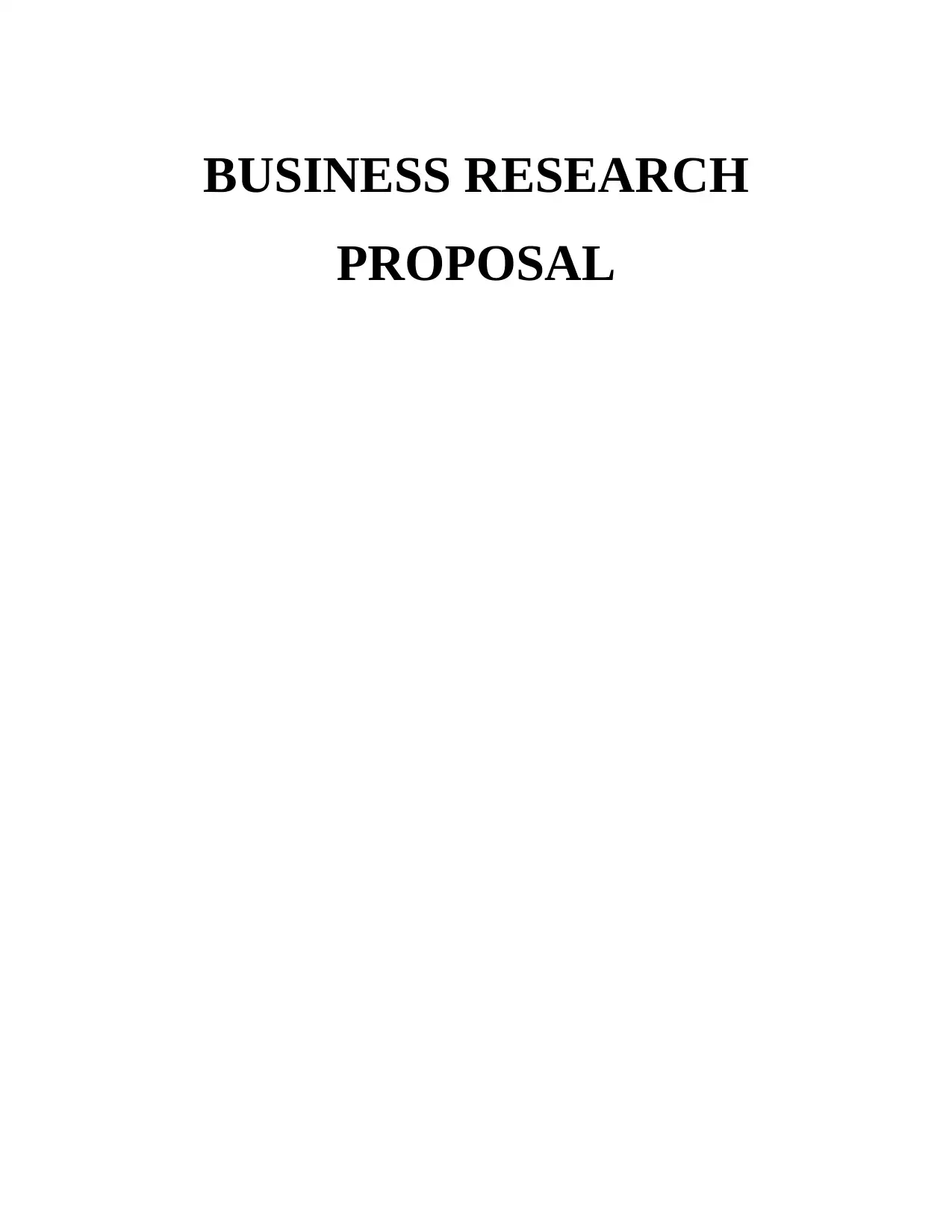
BUSINESS RESEARCH
PROPOSAL
PROPOSAL
Paraphrase This Document
Need a fresh take? Get an instant paraphrase of this document with our AI Paraphraser
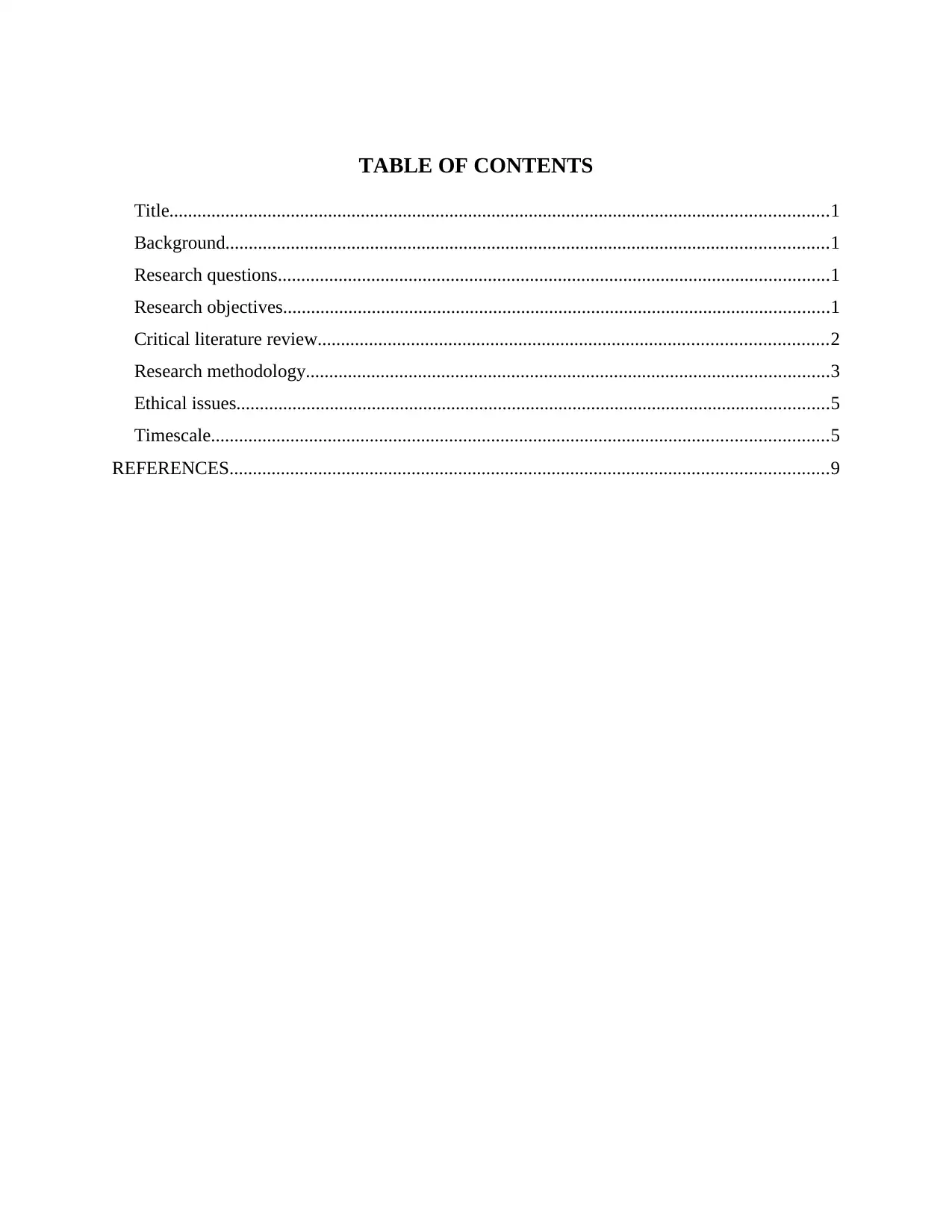
TABLE OF CONTENTS
Title.............................................................................................................................................1
Background.................................................................................................................................1
Research questions......................................................................................................................1
Research objectives.....................................................................................................................1
Critical literature review.............................................................................................................2
Research methodology................................................................................................................3
Ethical issues...............................................................................................................................5
Timescale....................................................................................................................................5
REFERENCES................................................................................................................................9
Title.............................................................................................................................................1
Background.................................................................................................................................1
Research questions......................................................................................................................1
Research objectives.....................................................................................................................1
Critical literature review.............................................................................................................2
Research methodology................................................................................................................3
Ethical issues...............................................................................................................................5
Timescale....................................................................................................................................5
REFERENCES................................................................................................................................9
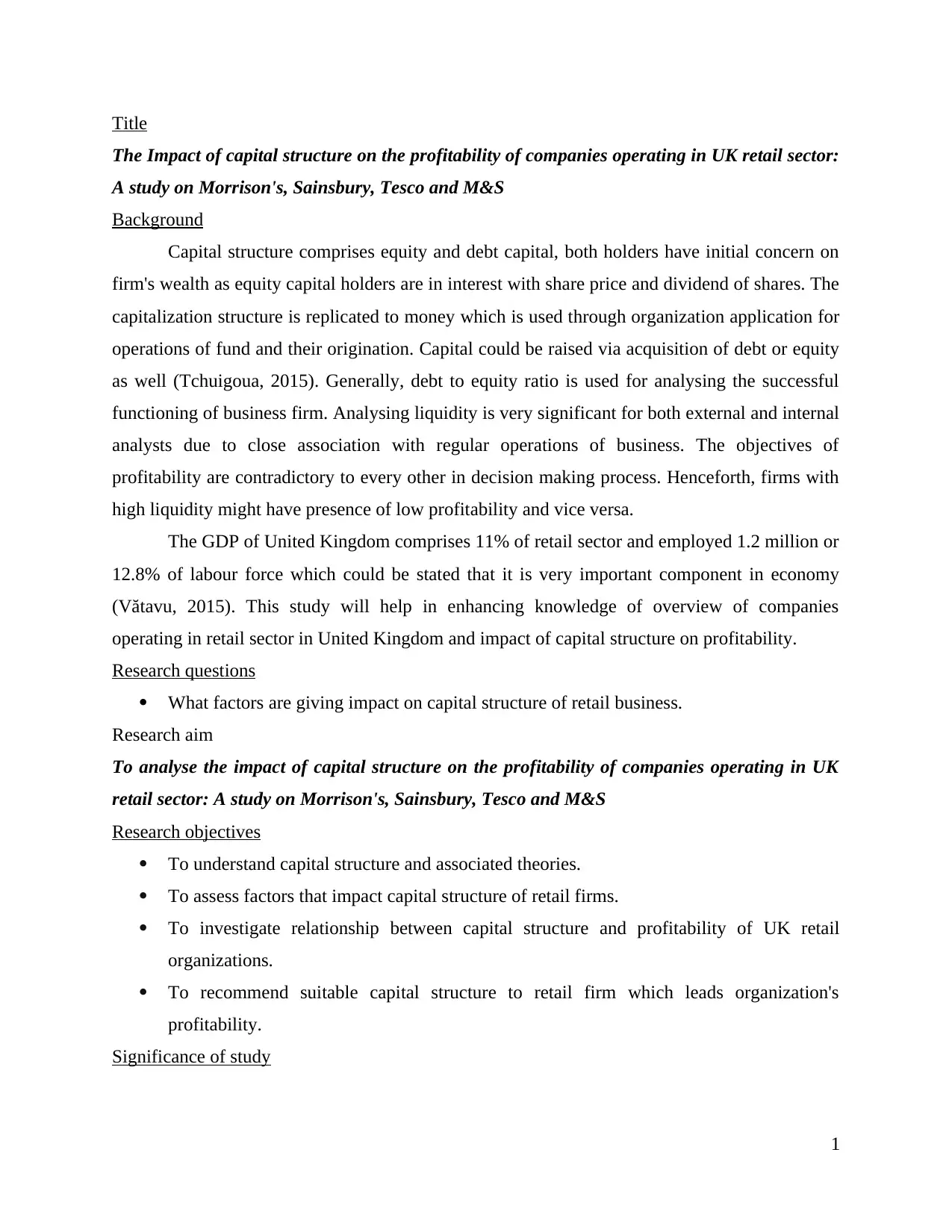
Title
The Impact of capital structure on the profitability of companies operating in UK retail sector:
A study on Morrison's, Sainsbury, Tesco and M&S
Background
Capital structure comprises equity and debt capital, both holders have initial concern on
firm's wealth as equity capital holders are in interest with share price and dividend of shares. The
capitalization structure is replicated to money which is used through organization application for
operations of fund and their origination. Capital could be raised via acquisition of debt or equity
as well (Tchuigoua, 2015). Generally, debt to equity ratio is used for analysing the successful
functioning of business firm. Analysing liquidity is very significant for both external and internal
analysts due to close association with regular operations of business. The objectives of
profitability are contradictory to every other in decision making process. Henceforth, firms with
high liquidity might have presence of low profitability and vice versa.
The GDP of United Kingdom comprises 11% of retail sector and employed 1.2 million or
12.8% of labour force which could be stated that it is very important component in economy
(Vătavu, 2015). This study will help in enhancing knowledge of overview of companies
operating in retail sector in United Kingdom and impact of capital structure on profitability.
Research questions
What factors are giving impact on capital structure of retail business.
Research aim
To analyse the impact of capital structure on the profitability of companies operating in UK
retail sector: A study on Morrison's, Sainsbury, Tesco and M&S
Research objectives
To understand capital structure and associated theories.
To assess factors that impact capital structure of retail firms.
To investigate relationship between capital structure and profitability of UK retail
organizations.
To recommend suitable capital structure to retail firm which leads organization's
profitability.
Significance of study
1
The Impact of capital structure on the profitability of companies operating in UK retail sector:
A study on Morrison's, Sainsbury, Tesco and M&S
Background
Capital structure comprises equity and debt capital, both holders have initial concern on
firm's wealth as equity capital holders are in interest with share price and dividend of shares. The
capitalization structure is replicated to money which is used through organization application for
operations of fund and their origination. Capital could be raised via acquisition of debt or equity
as well (Tchuigoua, 2015). Generally, debt to equity ratio is used for analysing the successful
functioning of business firm. Analysing liquidity is very significant for both external and internal
analysts due to close association with regular operations of business. The objectives of
profitability are contradictory to every other in decision making process. Henceforth, firms with
high liquidity might have presence of low profitability and vice versa.
The GDP of United Kingdom comprises 11% of retail sector and employed 1.2 million or
12.8% of labour force which could be stated that it is very important component in economy
(Vătavu, 2015). This study will help in enhancing knowledge of overview of companies
operating in retail sector in United Kingdom and impact of capital structure on profitability.
Research questions
What factors are giving impact on capital structure of retail business.
Research aim
To analyse the impact of capital structure on the profitability of companies operating in UK
retail sector: A study on Morrison's, Sainsbury, Tesco and M&S
Research objectives
To understand capital structure and associated theories.
To assess factors that impact capital structure of retail firms.
To investigate relationship between capital structure and profitability of UK retail
organizations.
To recommend suitable capital structure to retail firm which leads organization's
profitability.
Significance of study
1
⊘ This is a preview!⊘
Do you want full access?
Subscribe today to unlock all pages.

Trusted by 1+ million students worldwide
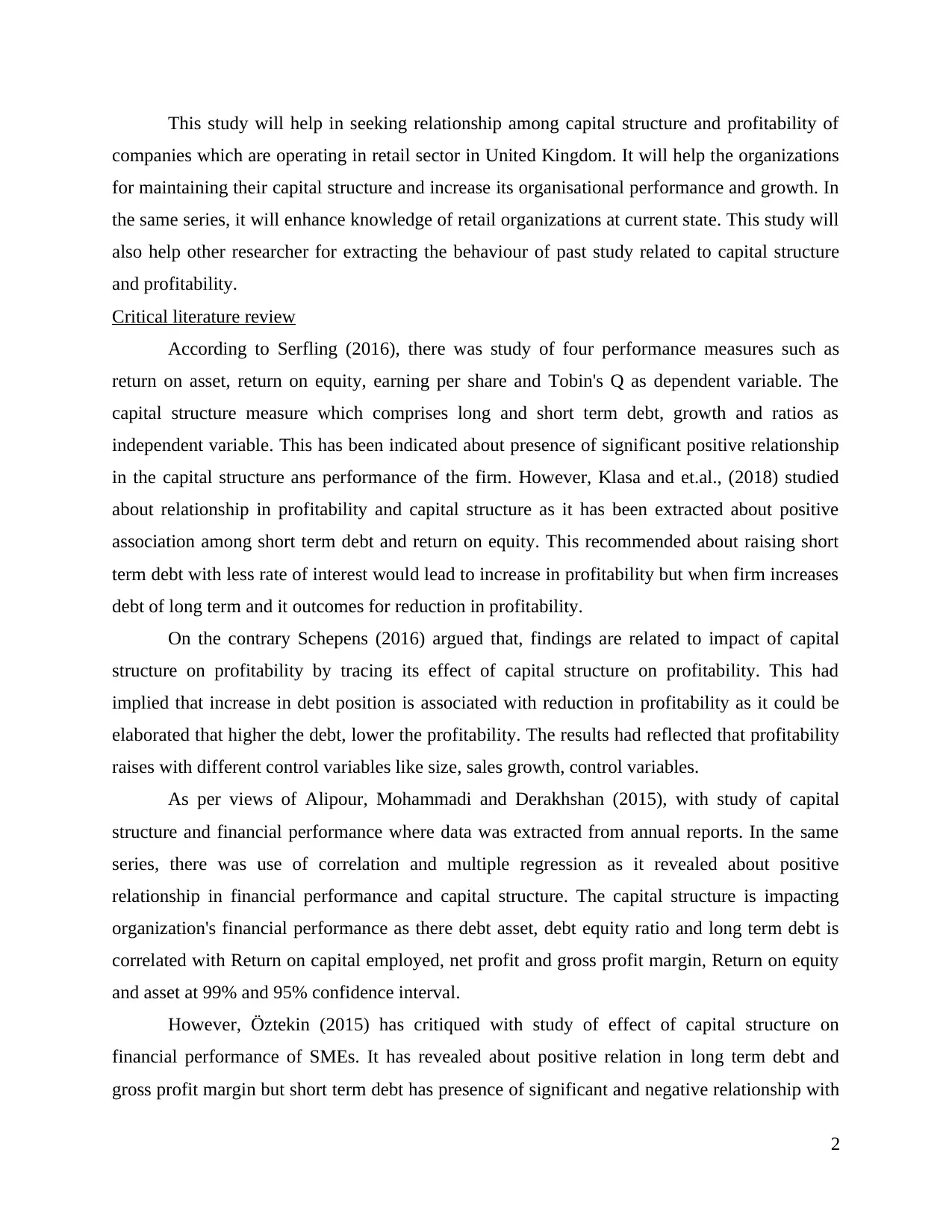
This study will help in seeking relationship among capital structure and profitability of
companies which are operating in retail sector in United Kingdom. It will help the organizations
for maintaining their capital structure and increase its organisational performance and growth. In
the same series, it will enhance knowledge of retail organizations at current state. This study will
also help other researcher for extracting the behaviour of past study related to capital structure
and profitability.
Critical literature review
According to Serfling (2016), there was study of four performance measures such as
return on asset, return on equity, earning per share and Tobin's Q as dependent variable. The
capital structure measure which comprises long and short term debt, growth and ratios as
independent variable. This has been indicated about presence of significant positive relationship
in the capital structure ans performance of the firm. However, Klasa and et.al., (2018) studied
about relationship in profitability and capital structure as it has been extracted about positive
association among short term debt and return on equity. This recommended about raising short
term debt with less rate of interest would lead to increase in profitability but when firm increases
debt of long term and it outcomes for reduction in profitability.
On the contrary Schepens (2016) argued that, findings are related to impact of capital
structure on profitability by tracing its effect of capital structure on profitability. This had
implied that increase in debt position is associated with reduction in profitability as it could be
elaborated that higher the debt, lower the profitability. The results had reflected that profitability
raises with different control variables like size, sales growth, control variables.
As per views of Alipour, Mohammadi and Derakhshan (2015), with study of capital
structure and financial performance where data was extracted from annual reports. In the same
series, there was use of correlation and multiple regression as it revealed about positive
relationship in financial performance and capital structure. The capital structure is impacting
organization's financial performance as there debt asset, debt equity ratio and long term debt is
correlated with Return on capital employed, net profit and gross profit margin, Return on equity
and asset at 99% and 95% confidence interval.
However, Öztekin (2015) has critiqued with study of effect of capital structure on
financial performance of SMEs. It has revealed about positive relation in long term debt and
gross profit margin but short term debt has presence of significant and negative relationship with
2
companies which are operating in retail sector in United Kingdom. It will help the organizations
for maintaining their capital structure and increase its organisational performance and growth. In
the same series, it will enhance knowledge of retail organizations at current state. This study will
also help other researcher for extracting the behaviour of past study related to capital structure
and profitability.
Critical literature review
According to Serfling (2016), there was study of four performance measures such as
return on asset, return on equity, earning per share and Tobin's Q as dependent variable. The
capital structure measure which comprises long and short term debt, growth and ratios as
independent variable. This has been indicated about presence of significant positive relationship
in the capital structure ans performance of the firm. However, Klasa and et.al., (2018) studied
about relationship in profitability and capital structure as it has been extracted about positive
association among short term debt and return on equity. This recommended about raising short
term debt with less rate of interest would lead to increase in profitability but when firm increases
debt of long term and it outcomes for reduction in profitability.
On the contrary Schepens (2016) argued that, findings are related to impact of capital
structure on profitability by tracing its effect of capital structure on profitability. This had
implied that increase in debt position is associated with reduction in profitability as it could be
elaborated that higher the debt, lower the profitability. The results had reflected that profitability
raises with different control variables like size, sales growth, control variables.
As per views of Alipour, Mohammadi and Derakhshan (2015), with study of capital
structure and financial performance where data was extracted from annual reports. In the same
series, there was use of correlation and multiple regression as it revealed about positive
relationship in financial performance and capital structure. The capital structure is impacting
organization's financial performance as there debt asset, debt equity ratio and long term debt is
correlated with Return on capital employed, net profit and gross profit margin, Return on equity
and asset at 99% and 95% confidence interval.
However, Öztekin (2015) has critiqued with study of effect of capital structure on
financial performance of SMEs. It has revealed about positive relation in long term debt and
gross profit margin but short term debt has presence of significant and negative relationship with
2
Paraphrase This Document
Need a fresh take? Get an instant paraphrase of this document with our AI Paraphraser
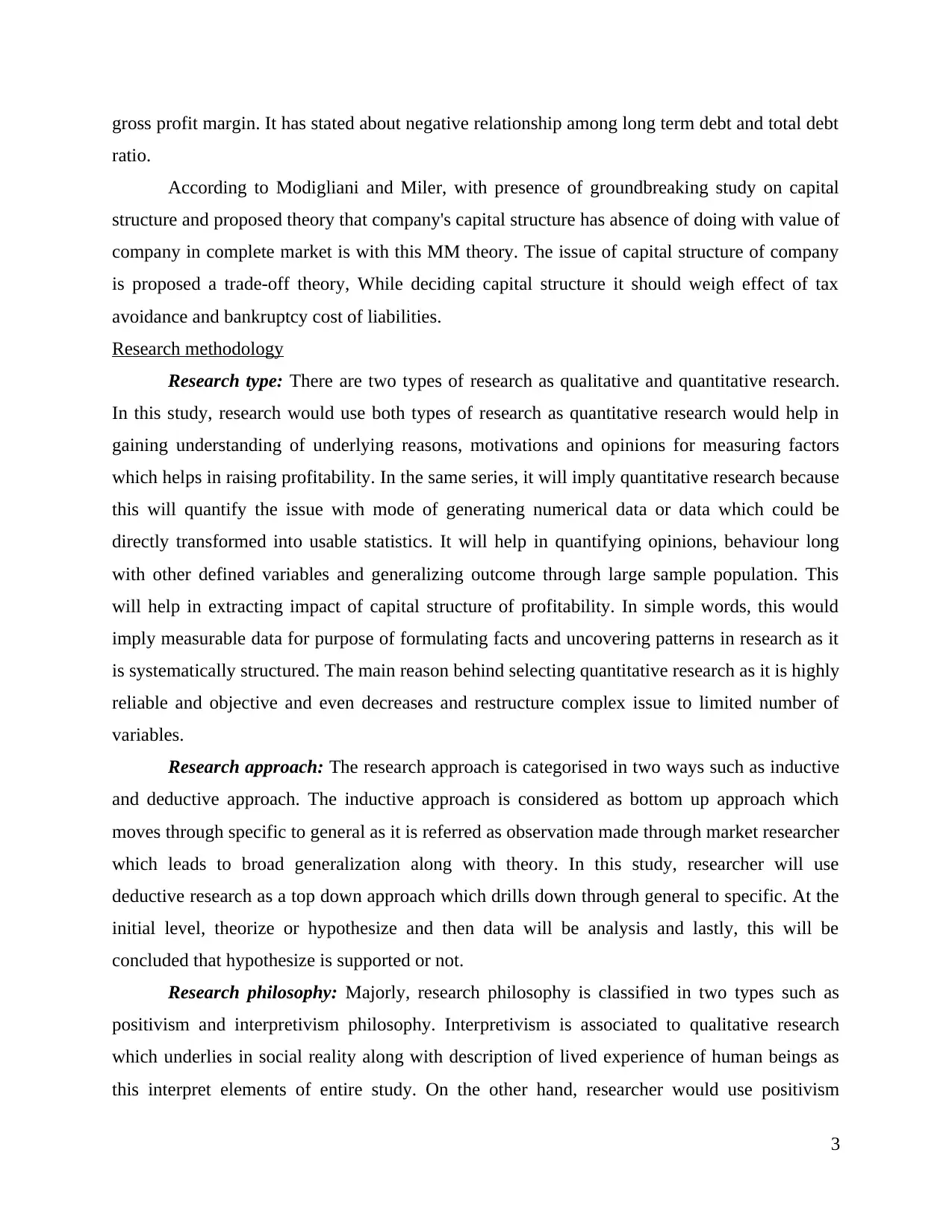
gross profit margin. It has stated about negative relationship among long term debt and total debt
ratio.
According to Modigliani and Miler, with presence of groundbreaking study on capital
structure and proposed theory that company's capital structure has absence of doing with value of
company in complete market is with this MM theory. The issue of capital structure of company
is proposed a trade-off theory, While deciding capital structure it should weigh effect of tax
avoidance and bankruptcy cost of liabilities.
Research methodology
Research type: There are two types of research as qualitative and quantitative research.
In this study, research would use both types of research as quantitative research would help in
gaining understanding of underlying reasons, motivations and opinions for measuring factors
which helps in raising profitability. In the same series, it will imply quantitative research because
this will quantify the issue with mode of generating numerical data or data which could be
directly transformed into usable statistics. It will help in quantifying opinions, behaviour long
with other defined variables and generalizing outcome through large sample population. This
will help in extracting impact of capital structure of profitability. In simple words, this would
imply measurable data for purpose of formulating facts and uncovering patterns in research as it
is systematically structured. The main reason behind selecting quantitative research as it is highly
reliable and objective and even decreases and restructure complex issue to limited number of
variables.
Research approach: The research approach is categorised in two ways such as inductive
and deductive approach. The inductive approach is considered as bottom up approach which
moves through specific to general as it is referred as observation made through market researcher
which leads to broad generalization along with theory. In this study, researcher will use
deductive research as a top down approach which drills down through general to specific. At the
initial level, theorize or hypothesize and then data will be analysis and lastly, this will be
concluded that hypothesize is supported or not.
Research philosophy: Majorly, research philosophy is classified in two types such as
positivism and interpretivism philosophy. Interpretivism is associated to qualitative research
which underlies in social reality along with description of lived experience of human beings as
this interpret elements of entire study. On the other hand, researcher would use positivism
3
ratio.
According to Modigliani and Miler, with presence of groundbreaking study on capital
structure and proposed theory that company's capital structure has absence of doing with value of
company in complete market is with this MM theory. The issue of capital structure of company
is proposed a trade-off theory, While deciding capital structure it should weigh effect of tax
avoidance and bankruptcy cost of liabilities.
Research methodology
Research type: There are two types of research as qualitative and quantitative research.
In this study, research would use both types of research as quantitative research would help in
gaining understanding of underlying reasons, motivations and opinions for measuring factors
which helps in raising profitability. In the same series, it will imply quantitative research because
this will quantify the issue with mode of generating numerical data or data which could be
directly transformed into usable statistics. It will help in quantifying opinions, behaviour long
with other defined variables and generalizing outcome through large sample population. This
will help in extracting impact of capital structure of profitability. In simple words, this would
imply measurable data for purpose of formulating facts and uncovering patterns in research as it
is systematically structured. The main reason behind selecting quantitative research as it is highly
reliable and objective and even decreases and restructure complex issue to limited number of
variables.
Research approach: The research approach is categorised in two ways such as inductive
and deductive approach. The inductive approach is considered as bottom up approach which
moves through specific to general as it is referred as observation made through market researcher
which leads to broad generalization along with theory. In this study, researcher will use
deductive research as a top down approach which drills down through general to specific. At the
initial level, theorize or hypothesize and then data will be analysis and lastly, this will be
concluded that hypothesize is supported or not.
Research philosophy: Majorly, research philosophy is classified in two types such as
positivism and interpretivism philosophy. Interpretivism is associated to qualitative research
which underlies in social reality along with description of lived experience of human beings as
this interpret elements of entire study. On the other hand, researcher would use positivism
3
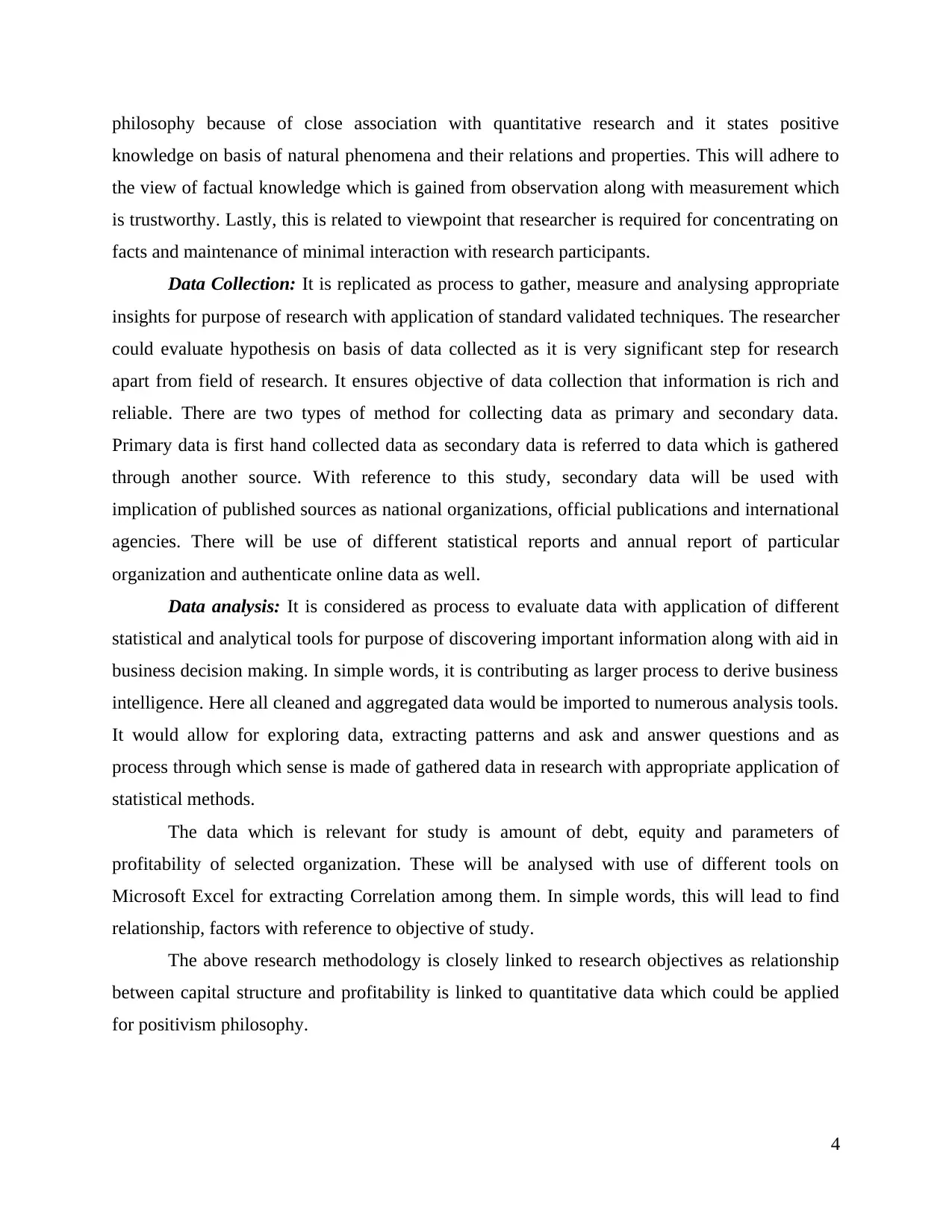
philosophy because of close association with quantitative research and it states positive
knowledge on basis of natural phenomena and their relations and properties. This will adhere to
the view of factual knowledge which is gained from observation along with measurement which
is trustworthy. Lastly, this is related to viewpoint that researcher is required for concentrating on
facts and maintenance of minimal interaction with research participants.
Data Collection: It is replicated as process to gather, measure and analysing appropriate
insights for purpose of research with application of standard validated techniques. The researcher
could evaluate hypothesis on basis of data collected as it is very significant step for research
apart from field of research. It ensures objective of data collection that information is rich and
reliable. There are two types of method for collecting data as primary and secondary data.
Primary data is first hand collected data as secondary data is referred to data which is gathered
through another source. With reference to this study, secondary data will be used with
implication of published sources as national organizations, official publications and international
agencies. There will be use of different statistical reports and annual report of particular
organization and authenticate online data as well.
Data analysis: It is considered as process to evaluate data with application of different
statistical and analytical tools for purpose of discovering important information along with aid in
business decision making. In simple words, it is contributing as larger process to derive business
intelligence. Here all cleaned and aggregated data would be imported to numerous analysis tools.
It would allow for exploring data, extracting patterns and ask and answer questions and as
process through which sense is made of gathered data in research with appropriate application of
statistical methods.
The data which is relevant for study is amount of debt, equity and parameters of
profitability of selected organization. These will be analysed with use of different tools on
Microsoft Excel for extracting Correlation among them. In simple words, this will lead to find
relationship, factors with reference to objective of study.
The above research methodology is closely linked to research objectives as relationship
between capital structure and profitability is linked to quantitative data which could be applied
for positivism philosophy.
4
knowledge on basis of natural phenomena and their relations and properties. This will adhere to
the view of factual knowledge which is gained from observation along with measurement which
is trustworthy. Lastly, this is related to viewpoint that researcher is required for concentrating on
facts and maintenance of minimal interaction with research participants.
Data Collection: It is replicated as process to gather, measure and analysing appropriate
insights for purpose of research with application of standard validated techniques. The researcher
could evaluate hypothesis on basis of data collected as it is very significant step for research
apart from field of research. It ensures objective of data collection that information is rich and
reliable. There are two types of method for collecting data as primary and secondary data.
Primary data is first hand collected data as secondary data is referred to data which is gathered
through another source. With reference to this study, secondary data will be used with
implication of published sources as national organizations, official publications and international
agencies. There will be use of different statistical reports and annual report of particular
organization and authenticate online data as well.
Data analysis: It is considered as process to evaluate data with application of different
statistical and analytical tools for purpose of discovering important information along with aid in
business decision making. In simple words, it is contributing as larger process to derive business
intelligence. Here all cleaned and aggregated data would be imported to numerous analysis tools.
It would allow for exploring data, extracting patterns and ask and answer questions and as
process through which sense is made of gathered data in research with appropriate application of
statistical methods.
The data which is relevant for study is amount of debt, equity and parameters of
profitability of selected organization. These will be analysed with use of different tools on
Microsoft Excel for extracting Correlation among them. In simple words, this will lead to find
relationship, factors with reference to objective of study.
The above research methodology is closely linked to research objectives as relationship
between capital structure and profitability is linked to quantitative data which could be applied
for positivism philosophy.
4
⊘ This is a preview!⊘
Do you want full access?
Subscribe today to unlock all pages.

Trusted by 1+ million students worldwide
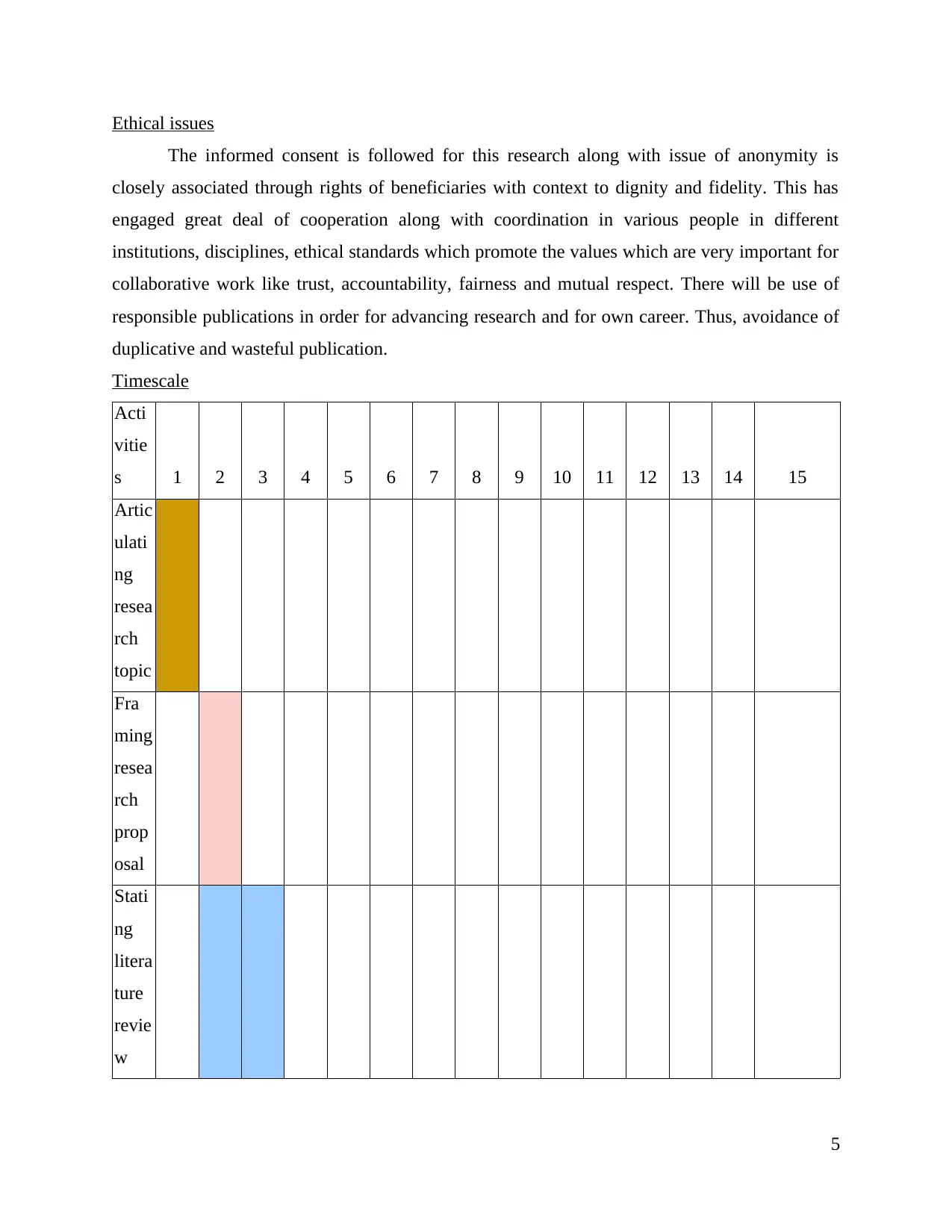
Ethical issues
The informed consent is followed for this research along with issue of anonymity is
closely associated through rights of beneficiaries with context to dignity and fidelity. This has
engaged great deal of cooperation along with coordination in various people in different
institutions, disciplines, ethical standards which promote the values which are very important for
collaborative work like trust, accountability, fairness and mutual respect. There will be use of
responsible publications in order for advancing research and for own career. Thus, avoidance of
duplicative and wasteful publication.
Timescale
Acti
vitie
s 1 2 3 4 5 6 7 8 9 10 11 12 13 14 15
Artic
ulati
ng
resea
rch
topic
Fra
ming
resea
rch
prop
osal
Stati
ng
litera
ture
revie
w
5
The informed consent is followed for this research along with issue of anonymity is
closely associated through rights of beneficiaries with context to dignity and fidelity. This has
engaged great deal of cooperation along with coordination in various people in different
institutions, disciplines, ethical standards which promote the values which are very important for
collaborative work like trust, accountability, fairness and mutual respect. There will be use of
responsible publications in order for advancing research and for own career. Thus, avoidance of
duplicative and wasteful publication.
Timescale
Acti
vitie
s 1 2 3 4 5 6 7 8 9 10 11 12 13 14 15
Artic
ulati
ng
resea
rch
topic
Fra
ming
resea
rch
prop
osal
Stati
ng
litera
ture
revie
w
5
Paraphrase This Document
Need a fresh take? Get an instant paraphrase of this document with our AI Paraphraser
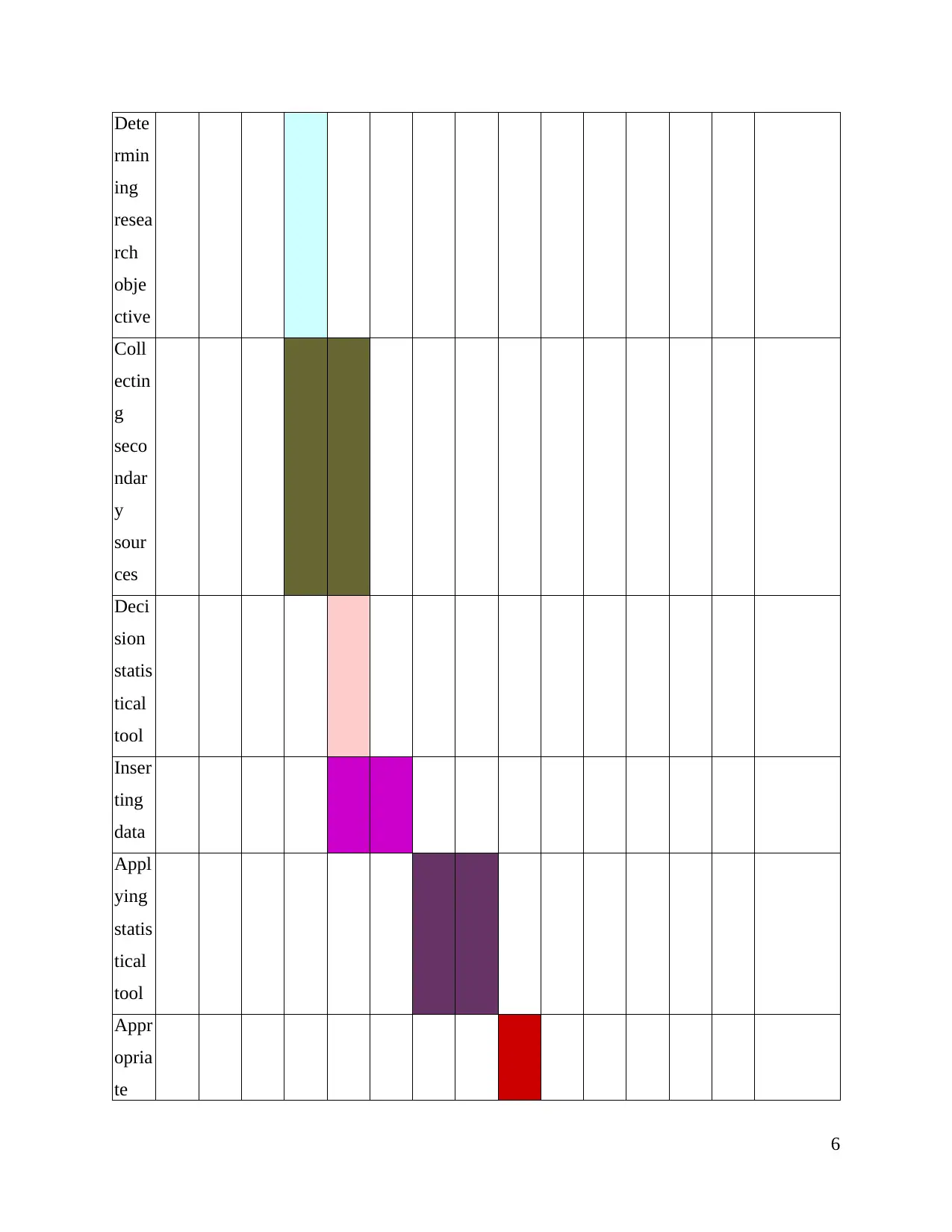
Dete
rmin
ing
resea
rch
obje
ctive
Coll
ectin
g
seco
ndar
y
sour
ces
Deci
sion
statis
tical
tool
Inser
ting
data
Appl
ying
statis
tical
tool
Appr
opria
te
6
rmin
ing
resea
rch
obje
ctive
Coll
ectin
g
seco
ndar
y
sour
ces
Deci
sion
statis
tical
tool
Inser
ting
data
Appl
ying
statis
tical
tool
Appr
opria
te
6
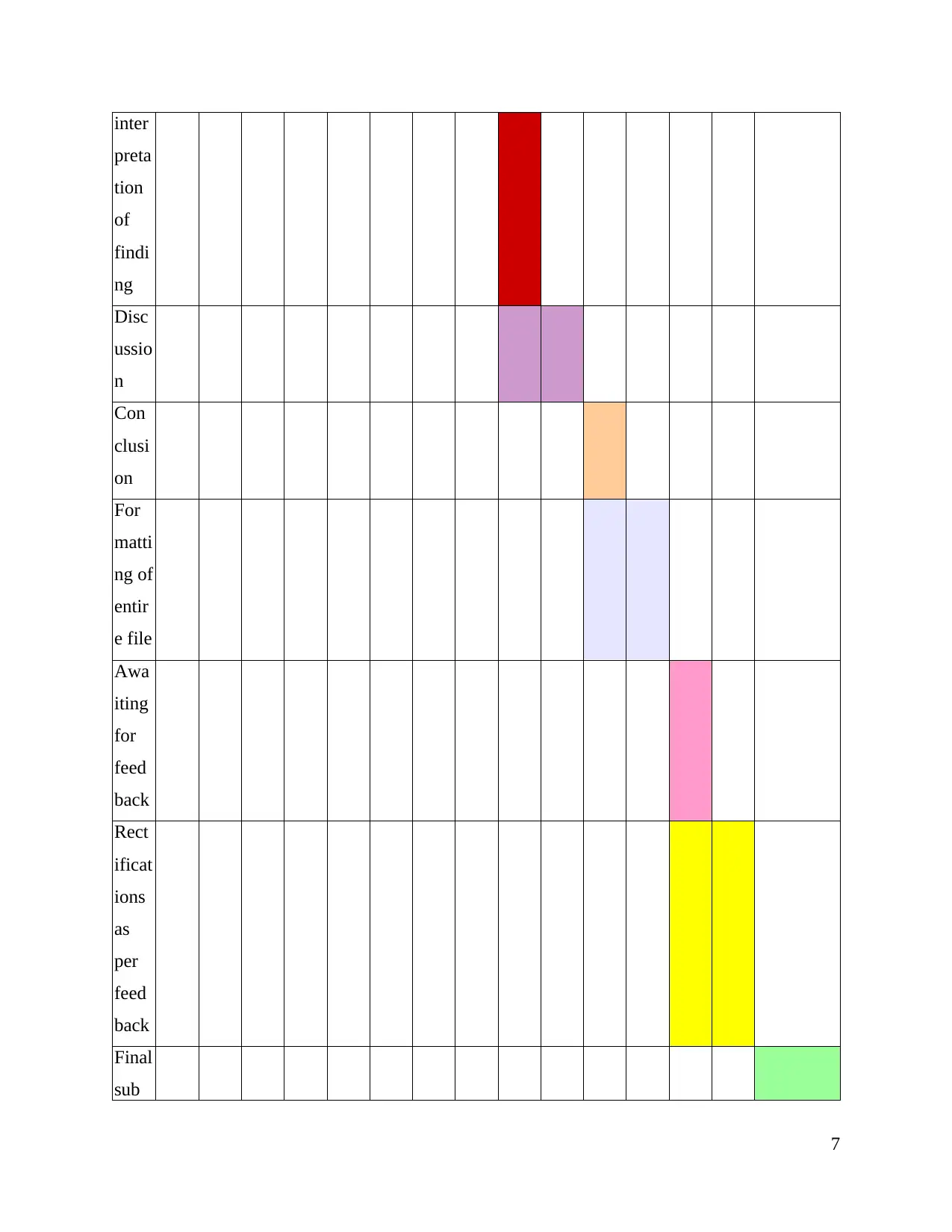
inter
preta
tion
of
findi
ng
Disc
ussio
n
Con
clusi
on
For
matti
ng of
entir
e file
Awa
iting
for
feed
back
Rect
ificat
ions
as
per
feed
back
Final
sub
7
preta
tion
of
findi
ng
Disc
ussio
n
Con
clusi
on
For
matti
ng of
entir
e file
Awa
iting
for
feed
back
Rect
ificat
ions
as
per
feed
back
Final
sub
7
⊘ This is a preview!⊘
Do you want full access?
Subscribe today to unlock all pages.

Trusted by 1+ million students worldwide

miss
ion
8
ion
8
Paraphrase This Document
Need a fresh take? Get an instant paraphrase of this document with our AI Paraphraser
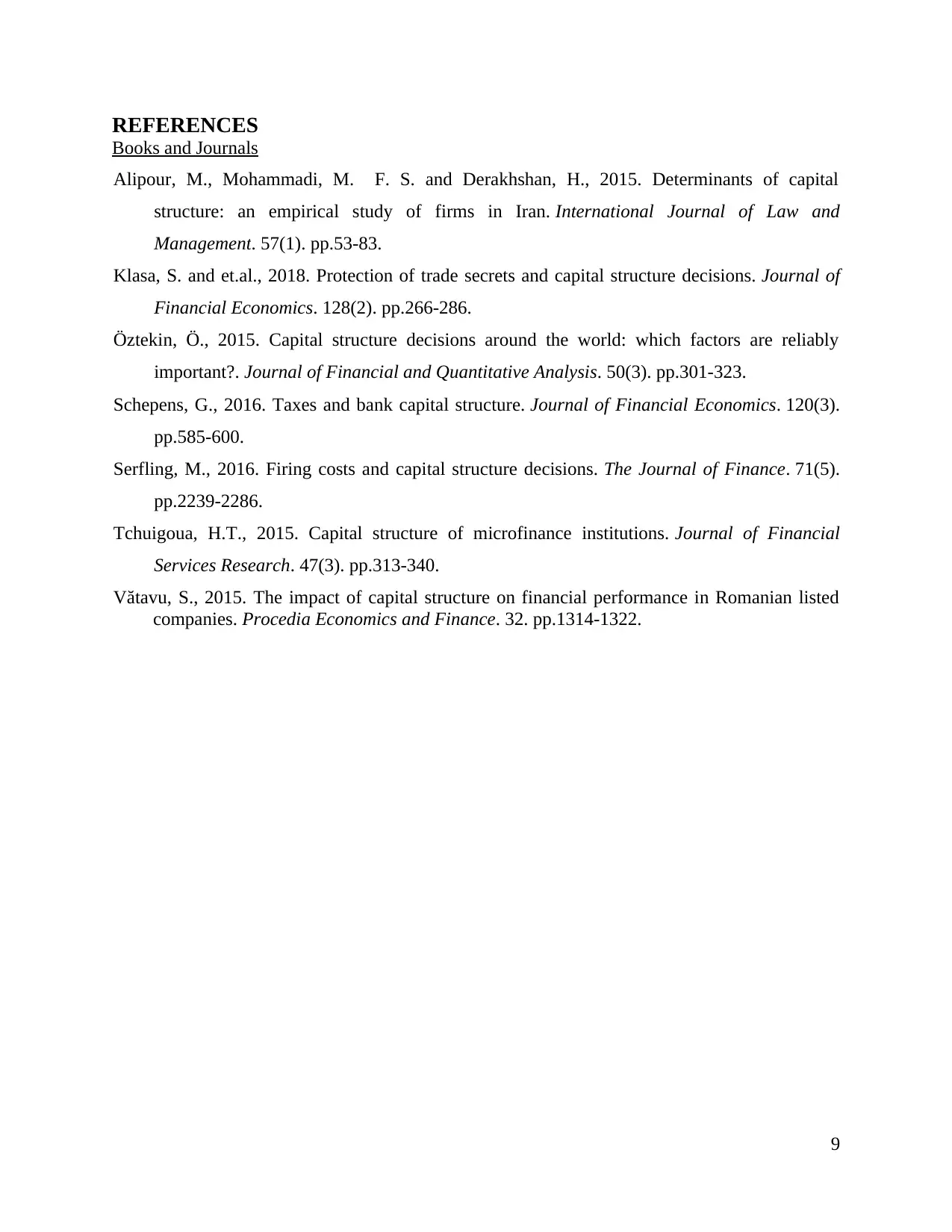
REFERENCES
Books and Journals
Alipour, M., Mohammadi, M. F. S. and Derakhshan, H., 2015. Determinants of capital
structure: an empirical study of firms in Iran. International Journal of Law and
Management. 57(1). pp.53-83.
Klasa, S. and et.al., 2018. Protection of trade secrets and capital structure decisions. Journal of
Financial Economics. 128(2). pp.266-286.
Öztekin, Ö., 2015. Capital structure decisions around the world: which factors are reliably
important?. Journal of Financial and Quantitative Analysis. 50(3). pp.301-323.
Schepens, G., 2016. Taxes and bank capital structure. Journal of Financial Economics. 120(3).
pp.585-600.
Serfling, M., 2016. Firing costs and capital structure decisions. The Journal of Finance. 71(5).
pp.2239-2286.
Tchuigoua, H.T., 2015. Capital structure of microfinance institutions. Journal of Financial
Services Research. 47(3). pp.313-340.
Vătavu, S., 2015. The impact of capital structure on financial performance in Romanian listed
companies. Procedia Economics and Finance. 32. pp.1314-1322.
9
Books and Journals
Alipour, M., Mohammadi, M. F. S. and Derakhshan, H., 2015. Determinants of capital
structure: an empirical study of firms in Iran. International Journal of Law and
Management. 57(1). pp.53-83.
Klasa, S. and et.al., 2018. Protection of trade secrets and capital structure decisions. Journal of
Financial Economics. 128(2). pp.266-286.
Öztekin, Ö., 2015. Capital structure decisions around the world: which factors are reliably
important?. Journal of Financial and Quantitative Analysis. 50(3). pp.301-323.
Schepens, G., 2016. Taxes and bank capital structure. Journal of Financial Economics. 120(3).
pp.585-600.
Serfling, M., 2016. Firing costs and capital structure decisions. The Journal of Finance. 71(5).
pp.2239-2286.
Tchuigoua, H.T., 2015. Capital structure of microfinance institutions. Journal of Financial
Services Research. 47(3). pp.313-340.
Vătavu, S., 2015. The impact of capital structure on financial performance in Romanian listed
companies. Procedia Economics and Finance. 32. pp.1314-1322.
9
1 out of 11
Related Documents
Your All-in-One AI-Powered Toolkit for Academic Success.
+13062052269
info@desklib.com
Available 24*7 on WhatsApp / Email
![[object Object]](/_next/static/media/star-bottom.7253800d.svg)
Unlock your academic potential
Copyright © 2020–2025 A2Z Services. All Rights Reserved. Developed and managed by ZUCOL.





